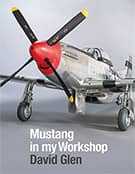Spitfire Mk IX Diary, page 6

Forgotten flaps – a remeidial task
Monday, 22nd August, 2016
Those who have seen my Mk 1 Spitfire will know that its flaps are extended. I believe the refinement adds hugely to the model, but...
Read more

Lining and detailing the wheel wells
Sunday, 21st August, 2016
Two years or more have passed since I last gave serious attention to the wings of my model, so when I inspected them in mid-June...
Read more

Friday, 19th August, 2016
As May rolled into June I felt the need for a break from sheet metal work - some light relief, let’s say – and for...
Read more

Tuesday, 16th August, 2016
With the fin brought to life by its full complement of tiny rivets inspection plates and screw fastener detail, there remained but one further task...
Read more

Monday, 15th August, 2016
According to their embedded dates, I took these pictures around the middle of May, evidence of further woeful neglect of my web log, and at...
Read more

Sunday, 19th June, 2016
As April rolled on into May, I set about the task of cladding the stern section of my Spitfire. The work took a couple of...
Read more

Saturday, 18th June, 2016
Completion of the horizontal stabiliser skin and its rivet and fastener detail opened the way for permanent installation of the empennage sub assemblies, something of...
Read more

Monday, 13th June, 2016
Metal skinning of the horizontal stabiliser is straightforward, and it begins with the facing of the trailing edge and tips with un-softened litho plate.
The...
Read more

Monday, 6th June, 2016
I made mention in my last diary entry of exhibiting my Spitfire fuselage at the London Model Engineering Exhibition in January. By that time the...
Read more

Saturday, 4th June, 2016
During December of last year I finally got down to the task of skinning the fuselage, or more accurately, that part of the fuselage aft...
Read more
Stories 51 to 60 of 125
Archive
- The sliding canopy frame
- Vac-forming the canopy
- Sliding canopy – the vac-form tool
- Installing the pilot's seat
- The pilot's seat completed
- Painting the rudder and elevators
- Empennage fixtures and fittings
- Rib stringing and taping
- Failed fabric
- 'Printed' pilot's seat
- Compass graphics assemblage
- Custom laser-cut rib tapes
- Empennage: The final details
- Warpaint: The squadron crest
- Warpaint: The 601 Sqn livery
- The Spitfire's tyres
- Machining the main landing wheels
- Fitting the exhaust stacks
- Leading edge wing root fillets
- Assembling the airscrew
- Skinning and fitting the ailerons
- Painting the exhaust stacks
- Undercarriage doors
- Rad cores and farings installed
- The radiator fairing doors
- Navigation lights installed
- A milestone – the wings completed!
- Return to action – the pitot tube
- Radiator fairings resumed
- Wing undersurfaces: Rad 'ramps'
- Wing undersurfaces: Riveting
- Wing undersurfaces: Gun covers
- Wing undersurfaces: Leading edge
- Top wing skin complete
- Some expert help
- Glaring error rectified
- Wing root fillets (upperside)
- Wing root fillets (underside)
- Wheel bay blisters
- Cannon blisters
- Blisters and cam-lock fasteners
- Finishing the flaps
- The wing tip skin
- Frog-eye nav light fairings
- Leading edge wing skin
- The gear strut channels
- Time to fit the wings
- The windscreen - Part 2
- The windscreen - Part 1
- The pilot's door
- Forgotten flaps – a remeidial task
- Lining and detailing the wheel wells
- The Spitfire's armament
- Horizontal stabiliser fillets
- Cladding the fin
- Cladding the stern section
- Installing the empennage
- Stabiliser Skin
- A second near disaster
- Cladding the fuselage
- Fuel tank cover
- The Spitfire's side cowls
- Top cowl and a major setback
- Belly skin and ident light
- An experiment in panel beating
- Finishing the Vokes air intake
- Installing the upper sidewalls
- Assembling the instrument faces
- Grapics for instrument faces
- Fitting out the instrument panel
- Fitting out the stbd upper sidewall
- Fitting out the port upper sidewall
- The chassis selector control
- The throttle quadrant
- Control column - Part 2
- Control column - Part 1
- Near disaster! A cautionary tale
- Fuse boxes and air filter control
- Magnetic compass and tray
- The instrument panel
- Upper cockpit walls
- Switch boxes and buttons
- Exhaust stack
- Oleo strut - Part 3
- Oleo strut - Part 2
- Oleo strut - Part 1
- The Spitfire's spinner
- Fitting out the port sidewall
- Filling gaps in the fuselage shell
- The seat support structure
- Head armour and volt regulator
- Fuel tank jettison controls
- The IFF switch assembly
- Oxygen and carbon dioxide
- Windscreen de-icing system
- Pneumatics 2: some ancillaries
- The rudder pedals
- The devil in the detail
- Rudder and elevator cables
- Pneumatic system 1: Air tanks
- Radiator fairings
- Empennage 2: The rudder
- Empennage 1: The elevators
- Casting the Vokes filter fairing
- Installing the nose section
- 'Sculpting' the wing root fairings
- Oleo strut supports
- Installing the wing centre section
- Wooden wing 2: underside
- Unexpected setback
- Wooden wing 1: topside
- Tail wheel and yoke
- Tail Strut
- An unsought interlude
- The built-up cockpit
- Plumbing preliminaries
- First internal skin panels
- Nose and fuselage balsa blocking
- Heel boards and rudder bars
- The visible fuselage frames
- Engineering or 'sleight of hand'?
- Fire bulkhead - first finished detail
- First cuts
- The planning stage
- Introduction

